Hawaii is home to some of the world’s most beautiful and unique birds. Hawaii is a birdwatcher’s paradise, from the state’s iconic nene goose to the colorful and vibrant tropical birds that inhabit its lush rainforests.
With nearly 400 species of birds, including many endemic to the islands, Hawaii offers a variety of bird habitats and species to explore. From the cliffs of the Big Island to the beaches of Maui, Hawaii is a haven of avian activity.
48 Hawaii Birds
Hawaii is a paradise for bird lovers, with nearly 400 species of birds recorded in the state. Many of these birds are endemic, meaning they are found nowhere else. However, Hawaii’s birds face many threats, such as habitat loss, invasive predators, diseases, and climate change.
Here are 48 Hawaiian birds, some of which are widespread and some rare and endangered. We hope you enjoy learning more about these amazing creatures and appreciate their beauty and diversity.
1. Nene
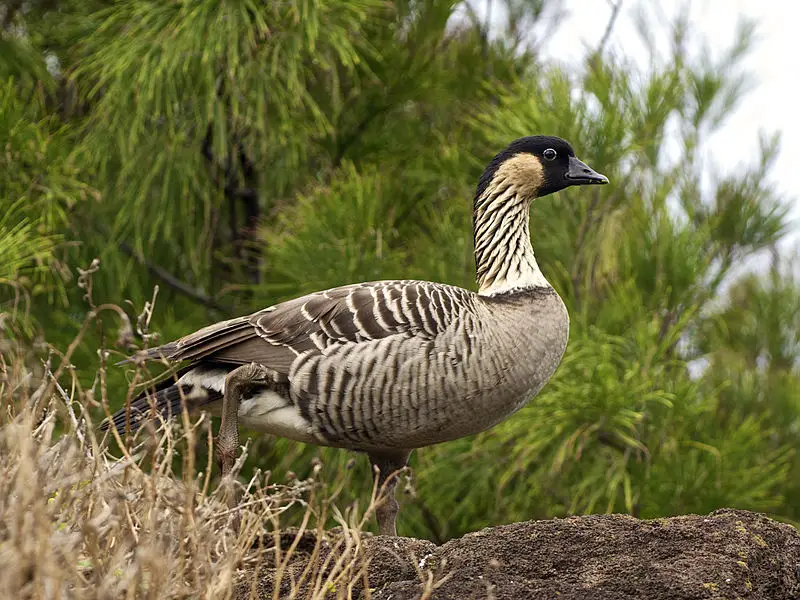
The Nene is a species of bird endemic to the Hawaiian Islands. It was given its name ‘nēnē’ due to its soft call, and in 1957, it even became the official state bird of Hawaii.
This gorgeous goose can be found exclusively in the wild on islands such as Oahu, Maui, Kauaʻi, Molokai, and Hawaiʻi.
The Nene have adapted so well to living within these different island environments that they have developed their distinct subspecies depending on which island they are from.
These birds are an important part of Hawaiian culture, featured in many stories throughout history where they were often seen as symbols for protection and good luck – making them truly special creatures.
Scientific classification:
| Kingdom | Animalia |
| Phylum | Chordata |
| Class | Aves |
| Order | Anseriformes |
| Family | Anatidae |
| Genus | Branta |
| Species | B. sandvicensis |
2. Hawaiian Honeycreeper
The Hawaiian honeycreepers are a unique group of birds native to the Hawaiian Islands. These small passerines have adapted features not seen in any other finch, making them incredibly diverse.
Since human arrival in Hawaii, many species of these beautiful creatures have been driven to extinction due to habitat destruction and competition with invasive species such as rats and mongooses.
However, conservation efforts are ongoing to protect remaining populations from further decline and reintroduce extinct ones back into their former habitats where possible.
With luck, we may one day see flocks of brilliantly colored honeycreepers grace Hawaii’s skies once again.
Scientific classification:
| Kingdom | Animalia |
| Phylum | Chordata |
| Class | Aves |
| Order | Passeriformes |
| Family | Fringillidae |
| Subfamily | Carduelinae |
Also Featured In: Birds of Kauai, Hawaii, Birds that Found in Maui
3. Common Myna
The Common Myna is a bird native to Asia and belongs to the Sturnidae family. It has an omnivorous diet, strong territorial instinct, and is well adapted to urban environments.
With its range increasing rapidly, it was declared one of the most invasive species by IUCN in 2000. Its distinctive features include a black head with a yellow bill, a brown body, and white tips on wings & tail feathers.
The common myna communicates through loud clicking noises that can be heard from long distances in rural and urban areas.
They are known for their intelligence; they mimic sounds such as human speech or other birds’ calls, making them popular pets among households.
Scientific classification:
| Kingdom | Animalia |
| Phylum | Chordata |
| Class | Aves |
| Order | Passeriformes |
| Family | Sturnidae |
| Genus | Acridotheres |
| Species | A. tristis |
4. Hawaiian Hawk
The Hawaiian hawk, or ʻio, is an endemic raptor found only on the Big Island of Hawaii. It is one of two birds of prey native to the island – the other being a short-eared owl.
Evidence suggests that it once inhabited five islands, but today, it can only be found on the Big Island.
This beautiful bird has distinctive white feathers and yellow legs and feet. Its diet includes small mammals, reptiles, insects, and carrion, which they hunt from above using their sharp vision.
The ‘Io plays an important role in keeping ecosystems balanced by controlling rodent populations and helping disperse seeds through consumption, providing biodiversity for various plants across different regions within Hawaii’s forests and grasslands.
Scientific classification:
| Kingdom | Animalia |
| Phylum | Chordata |
| Class | Aves |
| Order | Accipitriformes |
| Family | Accipitridae |
| Genus | Buteo |
| Species | B. solitarius |
Also Featured In: Hawaii Big Island Birds You Should Know, Common Carnivore Birds
5. Hawaiian Petrel
The Hawaiian petrel, or ʻuaʻu, is an endemic species to Hawai’i. Its striking dark gray-brown and white plumage makes it easily identifiable among the other birds of the islands.
It was once found on all main Hawaiian Islands except Niʻihau but has since been mostly restricted to Haleakalā crater on Maui, with smaller populations inhabiting Mauna Loa on Hawai’i and Waimea Canyon and Lāna‘ihale on Kaua’i.
This seabird feeds mainly at night by diving into the water for small fish, squid, octopus, and crustaceans.
The female lays a single egg in burrows located up high in protected mountain slopes, where it remains until fledging after a three-month incubation period by both parents.
To ensure their continued survival, these pets are protected from human activities through conservation efforts such as predator control programs that help protect newly hatched young from owls predating them before flight readiness.
Scientific classification:
| Kingdom | Animalia |
| Phylum | Chordata |
| Class | Aves |
| Order | Procellariiformes |
| Family | Procellariidae |
| Genus | Pterodroma |
| Species | P. sandwichensis |
Also Featured In: Most Common Oahu Birds, White Oahu Birds
6. Hawaiʻi ʻamakihi
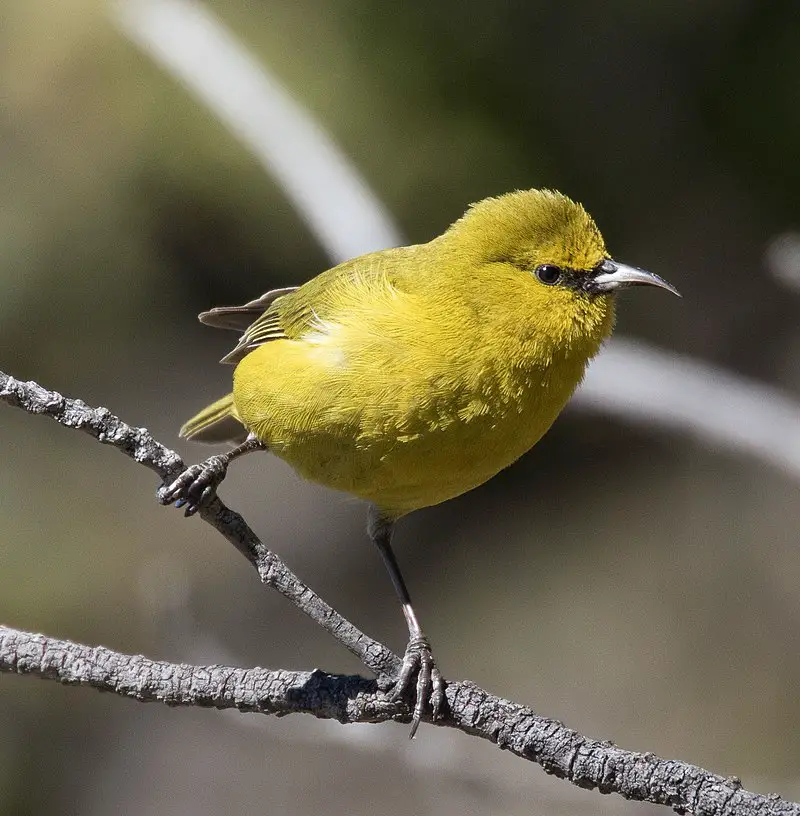
Hawaiʻi ʻamakihi is a species of Hawaiian honeycreeper belonging to the genus Chlorodrepanis.
It was previously placed in the Hemignathus group but was reclassified based on the analysis of mitochondrial and nuclear DNA sequences.
The two recognized subspecies are C. v. Wilson, found on Maui, Molokaʻi, and Lanai, and C. virus, occurring throughout Hawai’i Island except for the Kona district, where it has been extirpated due to habitat destruction from human activities such as urbanization and agriculture development.
The Hawaii amakihinest is mainly in the lowland ōhi’a forest dominated by Metrosideros polymorpha trees at elevations up to 900-1,800 meters (3,000–6,000 ft).
With its bright yellow breast feathers adorning its olive green body plumage, the Hawai` i `Amakihif flies gracefully through forests, searching for nectar sources like flowers or insects.
Scientific classification:
| Kingdom | Animalia |
| Phylum | Chordata |
| Class | Aves |
| Order | Passeriformes |
| Family | Fringillidae |
| Subfamily | Carduelinae |
| Genus | Chlorodrepanis |
| Species | C. virens |
7. ʻApapane
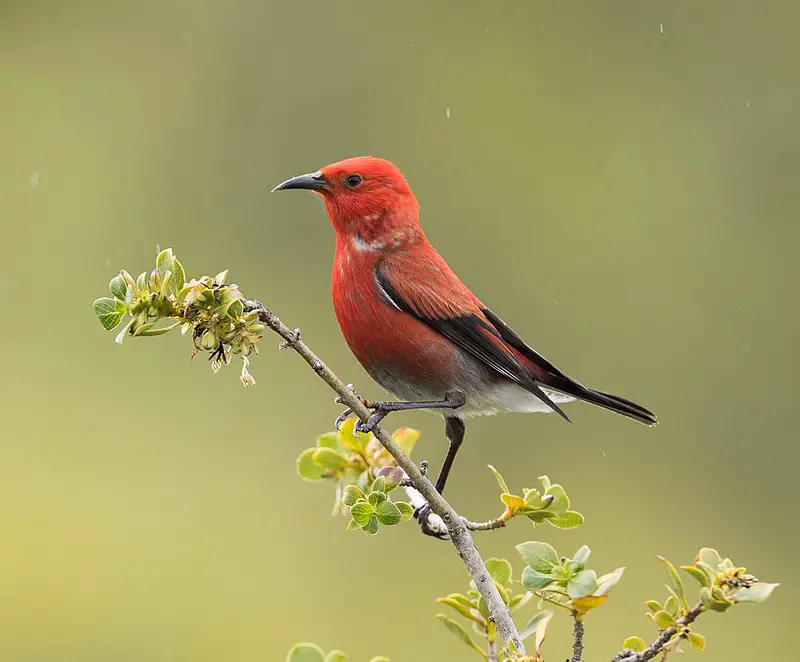
The ‘Apapane is a beautiful bird native to the Hawaiian Islands. It has bright crimson feathers and is a member of the honeycreeper family.
This small species can be found on all main islands, including Hawaiʻi, Maui, Lānaʻi, Kauaʻi, Molokaʻi and Oahu.
These birds are most commonly seen in ōhi’a trees, which feed off nectar from flowers and insects living among the foliage.
They nest high up in these tall hardwood trees and soar through rainforest treetops, looking for food sources with their long wingspan.
The ‘Apapane’s vibrant coloration makes it an iconic symbol of Hawaii’s diverse wildlife landscape; its cheerful presence often brings joy to visitors who have come to explore this tropical paradise.
Scientific classification:
| Kingdom | Animalia |
| Phylum | Chordata |
| Class | Aves |
| Order | Passeriformes |
| Family | Fringillidae |
| Subfamily | Carduelinae |
| Genus | Himatione |
| Species | H. sanguinea |
Also Featured In: Red Birds that Found in the United States America, Native Birds Of Kure Atoll
8. Northern Cardinal
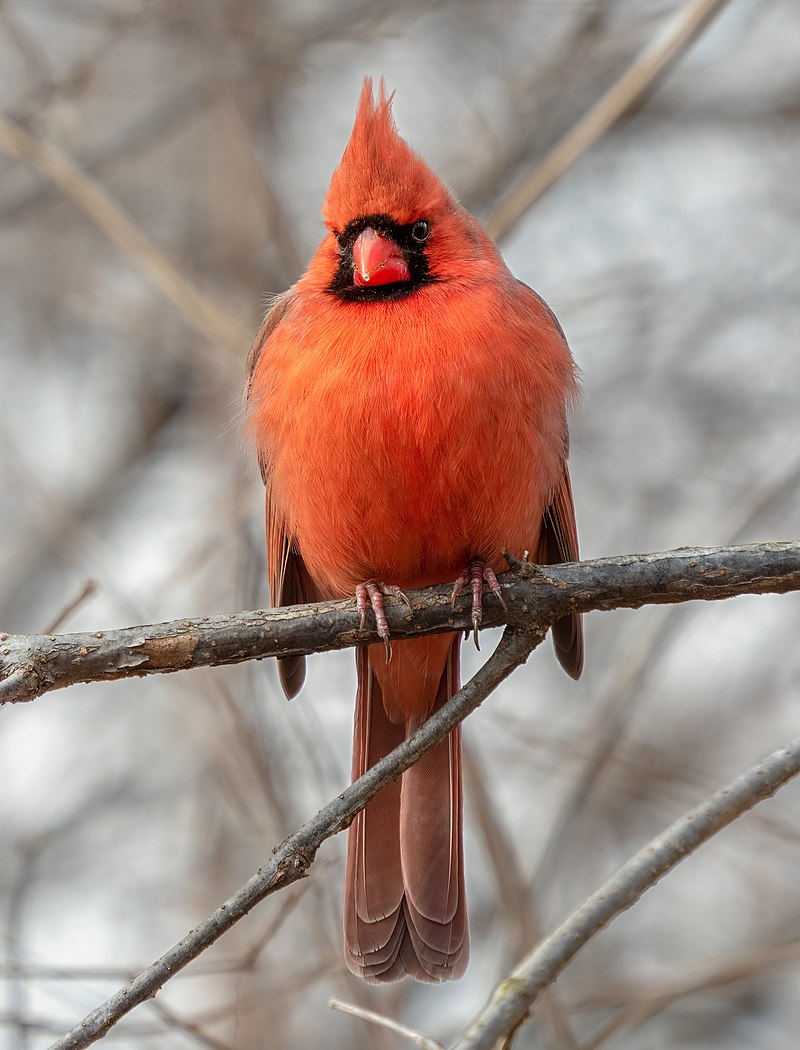
The Northern Cardinal is a beautiful bird, easily identified by its bright red plumage. It can be found in the eastern United States from Maine to Minnesota and south through Mexico and Belize.
Along with its striking coloration, it has a distinctive crest on its head and sharp black facial markings around the eyes.
Despite their small size (7-9 inches), they are very vocal birds – males sing persistently throughout springtime to attract mates or proclaim their territory.
They typically feed on insects, seeds, and fruits but enjoy suet at backyard bird feeders.
The female is less brightly colored than her mate but still stands out among other songbirds due to her warm brownish-red feathers.
Cardinals pair for life so you may often see them together in your garden or neighbourhood park.
Scientific classification:
| Kingdom | Animalia |
| Phylum | Chordata |
| Class | Aves |
| Order | Passeriformes |
| Family | Cardinalidae |
| Genus | Cardinalis |
| Species | C. cardinalis |
9. Red-Crested Cardinal
The Red-crested Cardinal is a brightly colored songbird belonging to the family of tanagers. It has a vibrant red crest and its name comes from the Tupí people, which means “small red, yellow, and gray bird”.
This species can be found in most parts of South America, where it prefers open woodlands or grassy areas near rivers.
Its diet consists mainly of insects but also includes some fruit when available. The Red-crested Cardinal is well known for its melodious songs used by males to attract mates during the breeding season.
These birds form monogamous pairs, with both parents helping raise their young until they learn how to fly on their own within 21 days after hatching from eggs in nests made up of high trees or bushes.
In recent years, there have been reports about population decline due to habitat loss caused by deforestation and illegal hunting for the pet trade business. Hence, conservation efforts are necessary to protect this beautiful species from extinction.
Scientific classification:
| Kingdom | Animalia |
| Phylum | Chordata |
| Class | Aves |
| Order | Passeriformes |
| Family | Thraupidae |
| Genus | Paroaria |
| Species | P. coronata |
10. Zebra Dove
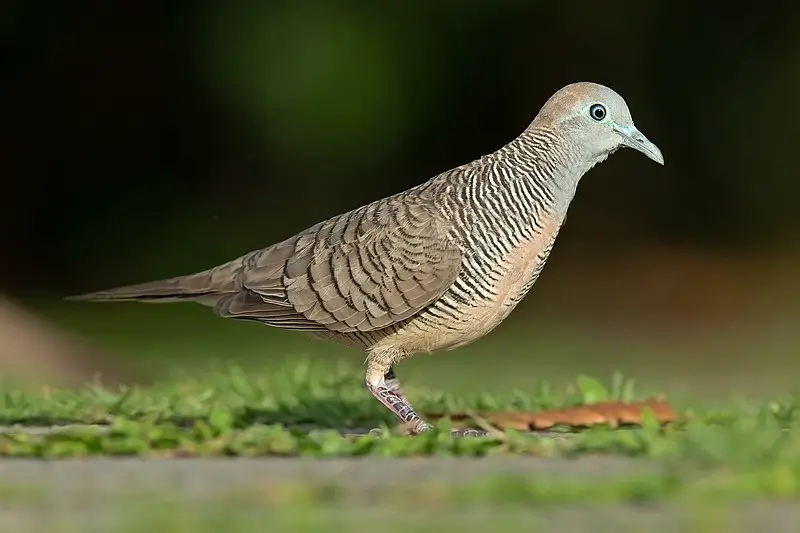
The Zebra Dove is a species of bird belonging to the Columbidae family. It can be found in Southeast Asia and has predominantly brownish-grey feathers with black-and-white barring.
This dove stands out for its soft, pleasant cooing calls that sound like staccato notes when heard together. George Edwards described it 1743 as part of his English naturalist work on birds.
They are small animals with long tails, making them easily identifiable even from afar due to their distinct color patterning.
These doves prefer open woodlands or grassy areas near human settlements where they feed on seeds and insects while nesting close by but still far enough away from disturbance caused by humans or other animals who might disrupt their habitat.
The zebra dove is considered an important symbol among some Asian cultures, representing love & beauty, reflecting how this little creature manages to capture people’s hearts wherever it goes.
Scientific classification:
| Kingdom | Animalia |
| Phylum | Chordata |
| Class | Aves |
| Order | Columbiformes |
| Family | Columbidae |
| Genus | Geopelia |
| Species | G. striata |
11. Warbling White-Eye
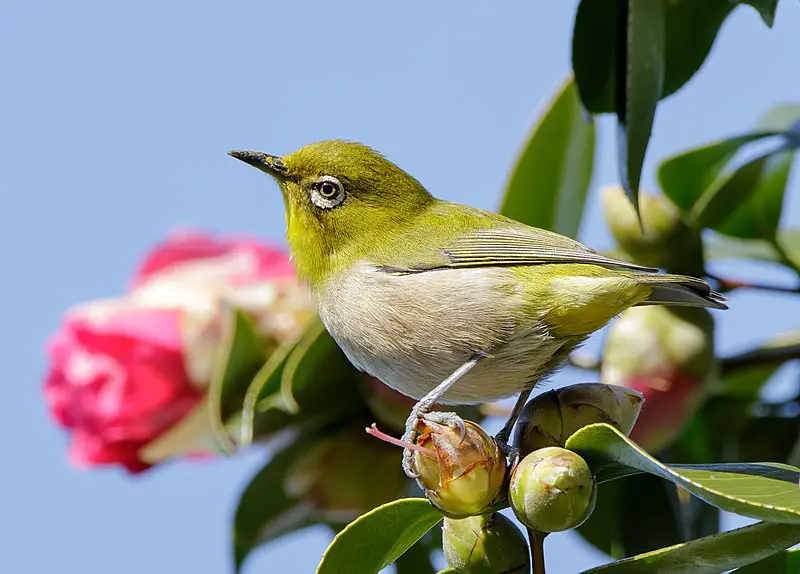
The Warbling White-Eye is a small passerine bird of the white-eye family, found in East Asia from Russia to Japan, Indonesia, Korea, and the Philippines.
Its distinct yellow forehead and olive back stand out amongst other birds. Its beady black eyes are surrounded by bright white rings, giving it an alert appearance.
A distinctive warble can be heard during breeding season when they form large flocks for food or shelter.
These flocks disperse into smaller groups during winter, making them elusive but never far away.
This beautiful little bird is an important part of many local ecosystems, so we should appreciate their beauty while protecting them from potential threats like habitat destruction and climate change.
Scientific classification:
| Kingdom | Animalia |
| Phylum | Chordata |
| Class | Aves |
| Order | Passeriformes |
| Family | Zosteropidae |
| Genus | Zosterops |
| Species | Z. japonicus |
12. ʻAkiapolaʻau
The ʻakiapōlāʻau is a species of Hawaiian honeycreeper that can only be found on the island of Hawaii.
It has an impressive 5.5-inch body, and its most remarkable feature is its curved beak, making it the only bird on the island to occupy this niche.
The ‘Akiapola’au mainly lives in dry or moist forests and feeds off insects using their unique bill to pry bark from trees for food.
They also use tools such as twigs and grasses when searching for invertebrates inside tree crevices.
Another interesting fact about this species is that they mate monogamously, meaning both parents take part equally in raising chicks together until they are mature enough to fly away independently.
All these features make them one of Hawaiis’s most fascinating endemic birds.
Scientific classification:
| Kingdom | Animalia |
| Phylum | Chordata |
| Class | Aves |
| Order | Passeriformes |
| Family | Fringillidae |
| Subfamily | Carduelinae |
| Genus | Hemignathus |
| Species | H. wilsoni |
13. Hawaiʻi ʻakepa
The Hawaiʻi ʻakepa is an endangered bird native to the Hawaiian Islands, first discovered by Western science during Captain James Cook’s third voyage around the world.
It has striking red plumage and a unique call that can be heard echoing through its tropical forest habitats.
This species was only recently split from other Loxops coccineus birds in 2015 by the North American Classification Committee of the AOU.
The Hawai’i ‘Akepa are also known for their beautiful feather leis, which were made with feathers collected during this expedition centuries ago.
Today, these lovely creatures face threats such as habitat destruction due to human activity and predation from non-native animals like rats and mongooses, making them more vulnerable than ever before.
Scientific classification:
| Kingdom | Animalia |
| Phylum | Chordata |
| Class | Aves |
| Order | Passeriformes |
| Family | Fringillidae |
| Subfamily | Carduelinae |
| Genus | Loxops |
| Species | L. coccineus |
14. White-Rumped Shama
The White-rumped Shama is a beautiful and popular bird of the Muscicapidae family. Native to densely vegetated habitats in India, Southeast Asia, and other places due to its popularity as a caged bird, it was formerly classified under the thrush family Turdidae.
It has distinctive features such as a white rump patch on upper tail coverts, which helps identify this species from others easily.
Male birds are known for their melodious singing capabilities, while females lack that quality or sing very little compared to males, making them perfect pets in households worldwide.
They feed mainly on insects but occasionally take fruits, too; they prefer living close to water bodies like streams, making them easy prey among predators when away from home.
Scientific classification:
| Kingdom | Animalia |
| Phylum | Chordata |
| Class | Aves |
| Order | Passeriformes |
| Family | Muscicapidae |
| Genus | Copsychus |
| Species | C. malabaricus |
Also Featured In: Most Common Songs Birds that Live around You, White Birds Commonly Found in Hawaii
15. Red-Whiskered Bulbul
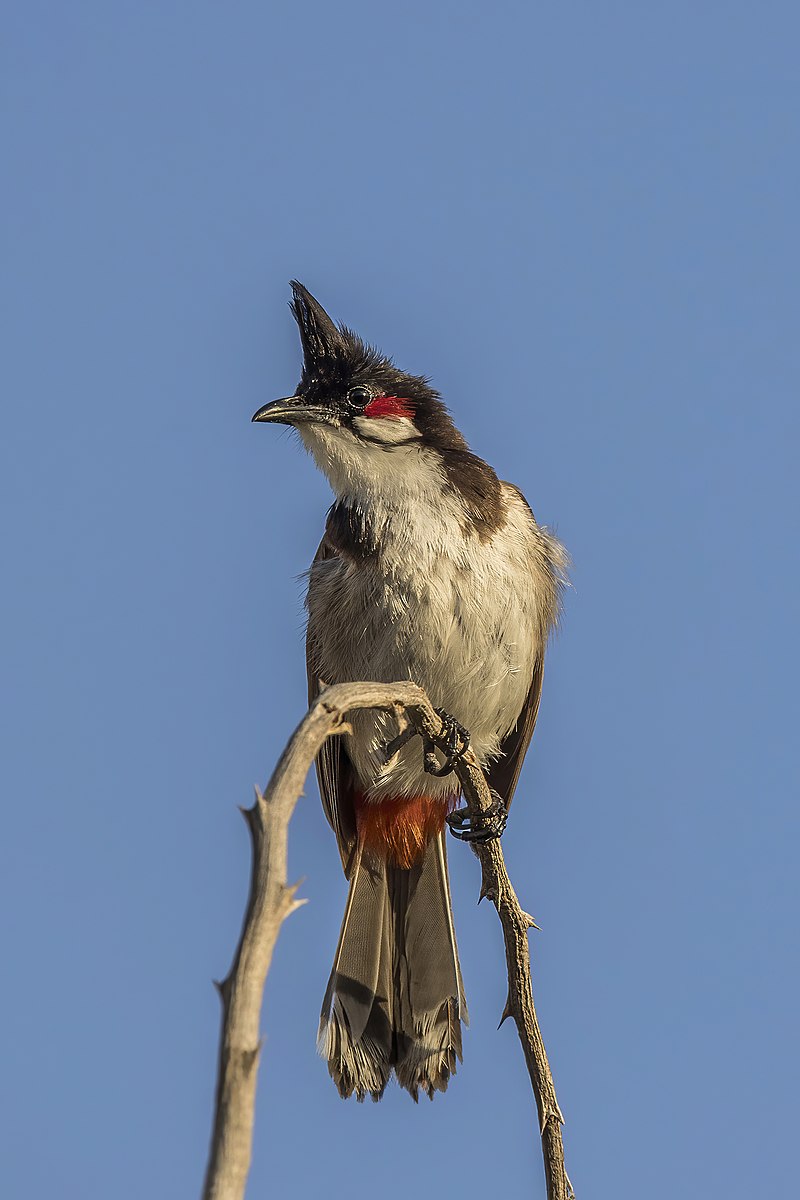
The Red-whiskered Bulbul is a passerine bird native to tropical Asia. It has an unmistakable black head, white cheek patch, and red whiskers on each side of its beak.
This brightly colored bulbul feeds mainly on fruits but occasionally eats small insects.
The birds are known for their loud call, which consists of three or four notes in succession and can often be heard emanating from treetops or other high perches where they like to sit conspicuously.
Introductions have been made in many parts of the world outside its original range, with populations establishing themselves successfully in various locations within the United States, including Hawaii and Florida.
Scientific classification:
| Kingdom | Animalia |
| Phylum | Chordata |
| Class | Aves |
| Order | Passeriformes |
| Family | Pycnonotidae |
| Genus | Pycnonotus |
| Species | P. jocosus |
16. Hawaiian Crow
The Hawaiian crow, or ʻalalā, is an extinct bird species from the family Corvidae. It was about 19-20 inches long and had soft brownish-black plumage with long, bristly throat feathers.
Its wings were rounded, and its bill was much thicker than most other crows.
Reintroduction efforts are underway to return this species to the wild, where they once lived on all islands except Kaua’i many years ago.
The population has been decimated due to habitat destruction and predation by invasive mammals such as mongooses and cats. However, there is still hope that these birds can be saved through conservation measures like captive breeding programs, which have already seen some success.
Scientific classification:
| Kingdom | Animalia |
| Phylum | Chordata |
| Class | Aves |
| Order | Passeriformes |
| Family | Corvidae |
| Genus | Corvus |
| Species | C. hawaiiensis |
17. Maui Parrotbill
The Maui parrotbill is a Hawaiian honeycreeper bird species endemic to the island of Maui in Hawaii.
It can be found only within 50 square kilometers on the windward slopes of Haleakalā at altitudes ranging from 1,200–2,150 meters.
This critically endangered species has an estimated population of 250-540 individuals as of 2016.
Despite conservation efforts such as increasing its habitat size and monitoring for disease outbreaks, it remains highly vulnerable due to predation by invasive rats and loss or degradation of its native forest habitat caused by feral animals like goats.
However, this beautiful species still stands a chance at survival with proper protection measures.
Scientific classification:
| Kingdom | Animalia |
| Phylum | Chordata |
| Class | Aves |
| Order | Passeriformes |
| Family | Fringillidae |
| Subfamily | Carduelinae |
| Genus | Pseudonestor Rothschild, 1893 |
| Species | P. xanthophrys |
18. Red-Billed Leiothrix
The Red-billed Leiothrix is a stunning bird native to southern China and the Himalayas. It has an olive green back, a bright yellow-orange throat, and a chin.
Males have brighter colors than females, while juveniles are noted for their black bills. The most striking feature of this species is its red bill, which gives it its name.
This bird can also be found in other parts of Asia due to intentional introductions by humans over time.
In addition to being eye-catching, the Red-billed Leiothrix is renowned for its melodic songs that fill forests with beautiful music during the breeding season.
All in all, these birds make for wonderful additions to any backyard or park setting.
Scientific classification:
| Kingdom | Animalia |
| Phylum | Chordata |
| Class | Aves |
| Order | Passeriformes |
| Family | Leiothrichidae |
| Genus | Leiothrix |
| Species | L. lutea |
Also Featured In: Most Common Nature Birds,
19. Java Sparrow
The Java sparrow is a small passerine bird from the estrildid finch family. It inhabits parts of Indonesia, including Java, Bali, and Bawean islands, but has also been introduced in many other countries as a popular cage bird.
Its size can vary from 13–14 cm, typically weighing around 20 grams. The feathers are brownish with white patches on their wings and tails, while males feature blackheads with pink or bluish beaks.
They feed mainly on grains like rice, millet, or sorghum, which explains their nickname “Java Rice Bird”; however, they have also developed an appetite for insects when living close to human settlements.
Scientific classification:
| Kingdom | Animalia |
| Phylum | Chordata |
| Class | Aves |
| Order | Passeriformes |
| Family | Estrildidae |
| Genus | Padda |
| Species | P. oryzivora |
20. Hawaiʻi ʻelepaio
The Hawaiʻi ʻelepaio is a small bird native to the Big Island of Hawaii. It belongs to the monarch flycatcher family, and until 2010, it was classified as one species alongside two other subspecies: Kauaʻi ʻelepaio and Oahu ʻelepaio.
This vibrant-colored bird boasts black upperparts with white wing bars, a gray head, and an orange-yellow breast.
It also has unique vocalizations that sound like “chee-dee” or “chup” while singing or searching for food in trees during the daytime.
The Hawai’i ‘Elepaios feed on insects such as beetles, spiders, and caterpillars by gleaning them from foliage near ground level up into canopy layers of trees – making them difficult to spot.
Considering these birds have been around since before the 1800s when first discovered by European settlers – there’s no doubt that this beautiful creature will remain part of Hawaiian culture for years to come.
Scientific classification:
| Kingdom | Animalia |
| Phylum | Chordata |
| Class | Aves |
| Order | Passeriformes |
| Family | Monarchidae |
| Genus | Chasiempis |
| Species | C. sandwichensis |
21. Palila
The Palila is a critically endangered species of Hawaiian honeycreeper, identified by its golden-yellow head and breast with a light belly, gray back, and greenish wings and tail.
It has an incredibly close relationship to the Māmane tree (Sophora chrysophylla) in terms of habitat.
Unfortunately, due to the destruction of these trees and their accompanying dry forests, this bird became endangered – first noted when the very first specimen was collected in 1889.
Conservation efforts have been put into place since then, but further protection for birds and habitats must be implemented to keep this unique species from extinction.
Scientific classification:
| Kingdom | Animalia |
| Phylum | Chordata |
| Class | Aves |
| Order | Passeriformes |
| Family | Fringillidae |
| Subfamily | Carduelinae |
| Genus | Loxioides |
| Species | L. bailleui |
22. Pacific Golden Plover
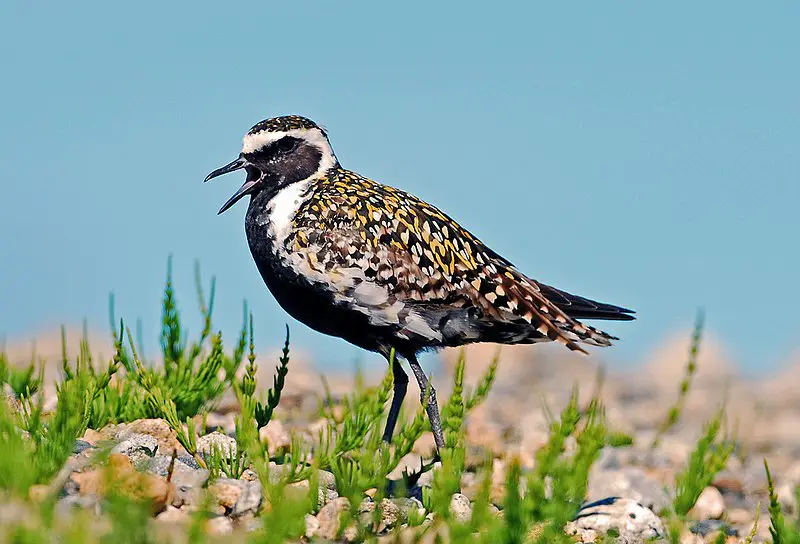
The Pacific golden plover (Pluvialis fulva) is an attractive migratory shorebird known for its breeding habits in Alaska and Siberia.
During the non-breeding season, these medium-sized birds migrate widely across the Pacific.
It was formally described by Johann Friedrich Gmelin in 1789 as part of his revised edition of Carl Linnaeus’s Systema Naturae.
The species has a unique yellowish coloration with dark markings on their wings and back, which gives them splendid camouflage against coastal rocks or sand beaches during migration periods.
They are omnivorous feeders who primarily eat insects, small crustaceans, worms, and plant material like seeds or berries found along coastlines while migrating through various islands such as Hawaii, New Zealand, etc.. A remarkable bird that possesses both beauty and resilience.
Scientific classification:
| Kingdom | Animalia |
| Phylum | Chordata |
| Class | Aves |
| Order | Charadriiformes |
| Family | Charadriidae |
| Genus | Pluvialis |
| Species | P. fulva |
Also Featured In: Birds You’ll Find in Vancouver Island, Birds that Migrate to Sri Lankan
23. Red-Vented Bulbul
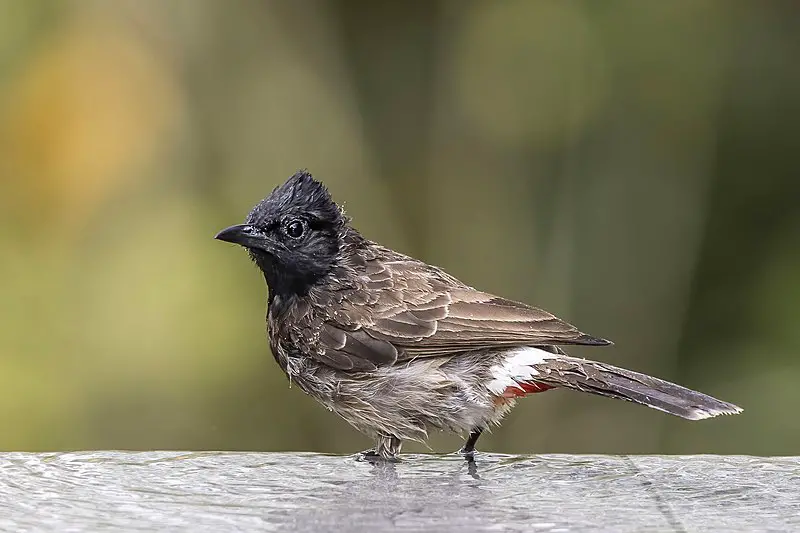
The Red-vented Bulbul is an impressive bird native to the Indian subcontinent and has been introduced to regions worldwide.
It belongs to the Bulbul family of passerines and is a resident breeder in many countries, including Sri Lanka, Burma, Bhutan, and Nepal.
It also thrives in New Zealand, Argentina, Tonga, and Fiji, as well as parts of Samoa, Australia, the USA, and the Cook Islands.
This species has grey heads with white cheeks contrasting sharply against their black wings with bright red vent feathers, giving them their name.
They typically live near woodland areas where they can forage for fruits or small insects on trees or bushes; this makes them useful birds for controlling insect populations naturally.
The male red-vented bulbuls are renowned songsters who sing out from treetops at dawn each day, adding beautiful melodies to any garden.
Scientific classification:
| Kingdom | Animalia |
| Phylum | Chordata |
| Class | Aves |
| Order | Passeriformes |
| Family | Pycnonotidae |
| Genus | Pycnonotus |
| Species | P. cafer |
24. ʻŌmaʻo
The ʻōmaʻo, also known as the Hawaiian thrush, is an endemic bird species native to Hawaii. It belongs to a family of robin-like birds that includes the kāmaʻo, oloma’o and puaiohi.
They are found primarily in the Big Island’s eastern and southeastern rainforests.
Current population estimates suggest their numbers remain steady at around 10,000 individuals across various habitats, such as dense understory vegetation in Kau forest reserves and more open areas like pastures or grassland slopes with scattered trees.
Though not currently threatened by extinction due to its wide range of suitable habitat types, human development has led to some population decline over time. Hence, conservation efforts are necessary for these unique birds’ continued survival.
Scientific classification:
| Kingdom | Animalia |
| Phylum | Chordata |
| Class | Aves |
| Order | Passeriformes |
| Family | Turdidae |
| Genus | Myadestes |
| Species | M. obscurus |
25. House Finch

The House Finch is a species of finch native to western North America and has been introduced in the eastern half of the continent and Hawaii.
It’s an average-sized finch with adults measuring 12.5 – 15 cm (5 – 6 inches) long and wingspan between 20 – 25 cm (8 – 10 inches).
The upperparts are brown, while its underparts range from pale grayish white to yellow depending on subspecies.
Its face is streaked or spotted with reddish coloration; males typically have brighter plumage than females due to sexual dimorphism.
They’re mostly found near human habitations such as farms and gardens, where they feed on grains, fruits, insects, etc., making them very popular among birders who want something colorful for their backyard.
Scientific classification:
| Kingdom | Animalia |
| Phylum | Chordata |
| Class | Aves |
| Order | Passeriformes |
| Family | Fringillidae |
| Subfamily | Carduelinae |
| Genus | Haemorhous |
| Species | H. mexicanus |
26. Laysan Albatross
The Laysan albatross is a large seabird found in the North Pacific Ocean. Most of its population (99.7%) resides in the Northwestern Hawaiian Islands, where they form strong colonies and thrive in their natural habitat.
They are small for an albatross but still have distinguishable features such as long wingspans that help them soar gracefully above oceans while searching for food over great distances with ease.
It’s estimated to have 1.18 million birds worldwide and continues to expand or re-expand its range throughout other areas of the oceanic region.
Scientific classification:
| Kingdom | Animalia |
| Phylum | Chordata |
| Class | Aves |
| Order | Procellariiformes |
| Family | Diomedeidae |
| Genus | Phoebastria |
| Species | P. immutabilis |
27. Hawaiʻi Creeper
The Hawaiʻi creeper, also known as the ʻalawī, is an endemic Hawaiian honeycreeper species found exclusively on the Big Island. It inhabits two types of forests—dry and montane moist—at elevations between 1000-2300ft.
There are 12000 individuals spread over three populations, with a potential fourth population in western parts of the island that may be migratory birds.
The bird has soft yellow plumage with olive green wings and back, while its head is adorned by black facial markings running from eyes to bill base.
Its diet consists mainly of insects, and it only forages from tree branches or low shrubs in groups or pairs during daylight hours.
This little beauty can often be heard singing its sweet trill song throughout forested areas, making it one of Hawaii’s most beloved avian inhabitants.
Scientific classification:
| Kingdom | Animalia |
| Phylum | Chordata |
| Class | Aves |
| Order | Passeriformes |
| Family | Fringillidae |
| Subfamily | Carduelinae |
| Genus | Loxops |
| Species | L. mana |
28. Red-Tailed Tropicbird
The Red-tailed Tropicbird is an exotic seabird found in tropical areas of the Indian and Pacific Oceans. Its striking appearance is mostly white feathers and a black mask covering its eyes.
Its bright red bill makes it stand out against its pale plumage. Both males and females have similar looks – unlike many other bird species where the male looks significantly different from the female.
As described by Pieter Boddaert in 1783, this impressive bird can be seen soaring through tropical skies, looking for food alone or within small flocks made up of several individuals at once.
Scientific classification:
| Kingdom | Animalia |
| Phylum | Chordata |
| Class | Aves |
| Order | Phaethontiformes |
| Family | Phaethontidae |
| Genus | Phaethon |
| Species | P. rubricauda |
29. Red-Footed Booby
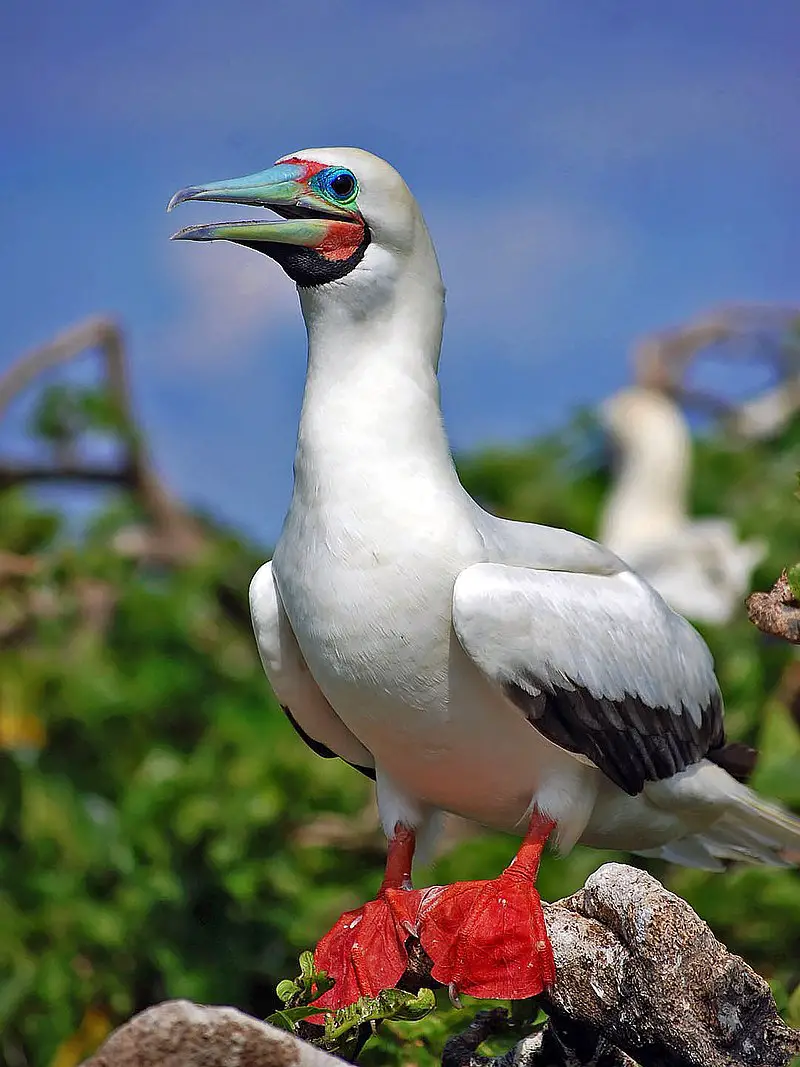
The Red-footed Booby is a large seabird of the Sulidae family, easily distinguished by its bright red feet. These birds are strong and agile fliers but can be clumsy in takeoffs and landings.
They live mostly in tropical areas and breed colonially on coastal islands worldwide.
The species faces few threats from either nature or humans, however their population has decreased slightly due to disturbances near breeding sites.
Despite this mild decline, they remain an incredibly common sight across many parts of the tropics – so much so that they have become symbolic of island life.
Scientific classification:
| Kingdom | Animalia |
| Phylum | Chordata |
| Class | Aves |
| Order | Suliformes |
| Family | Sulidae |
| Genus | Sula |
| Species | S. sula |
30. Spotted Dove
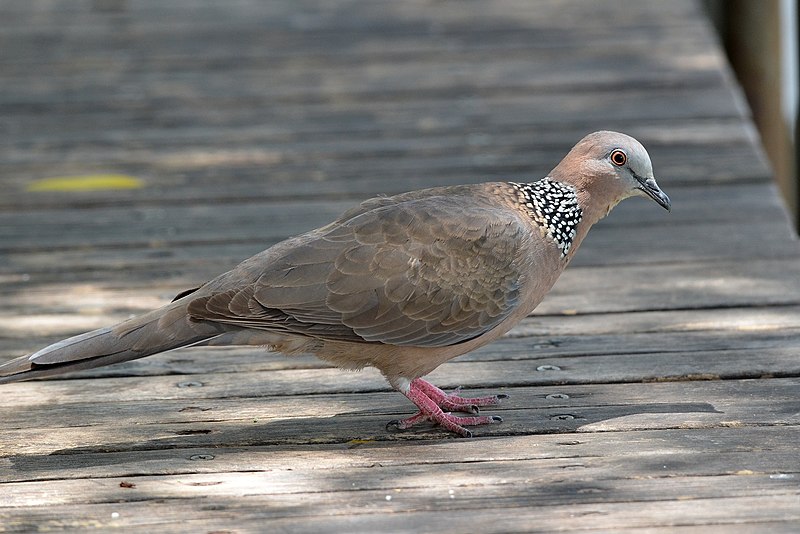
The Spotted Dove is a common species of pigeon found in the Indian subcontinent and Southeast Asia. It has an elegant, slender body with a small head, long tail feathers, and spotted wings.
Its coloring ranges from grey to brownish-grey on its upperparts with white underparts speckled black or dark grey. The male generally has more prominent spots than the female.
They feed mainly on seeds but will also consume insects when available during the breeding season and berries, grains, and fruits throughout their range.
These birds typically live in pairs or small groups near water sources such as ponds, rivers, or streams, where they can find food easily while staying safe from predators like cats and hawks.
Scientific classification:
| Kingdom | Animalia |
| Phylum | Chordata |
| Class | Aves |
| Order | Columbiformes |
| Family | Columbidae |
| Genus | Spilopelia |
| Species | S. chinensis |
31. Rose-Ringed Parakeet
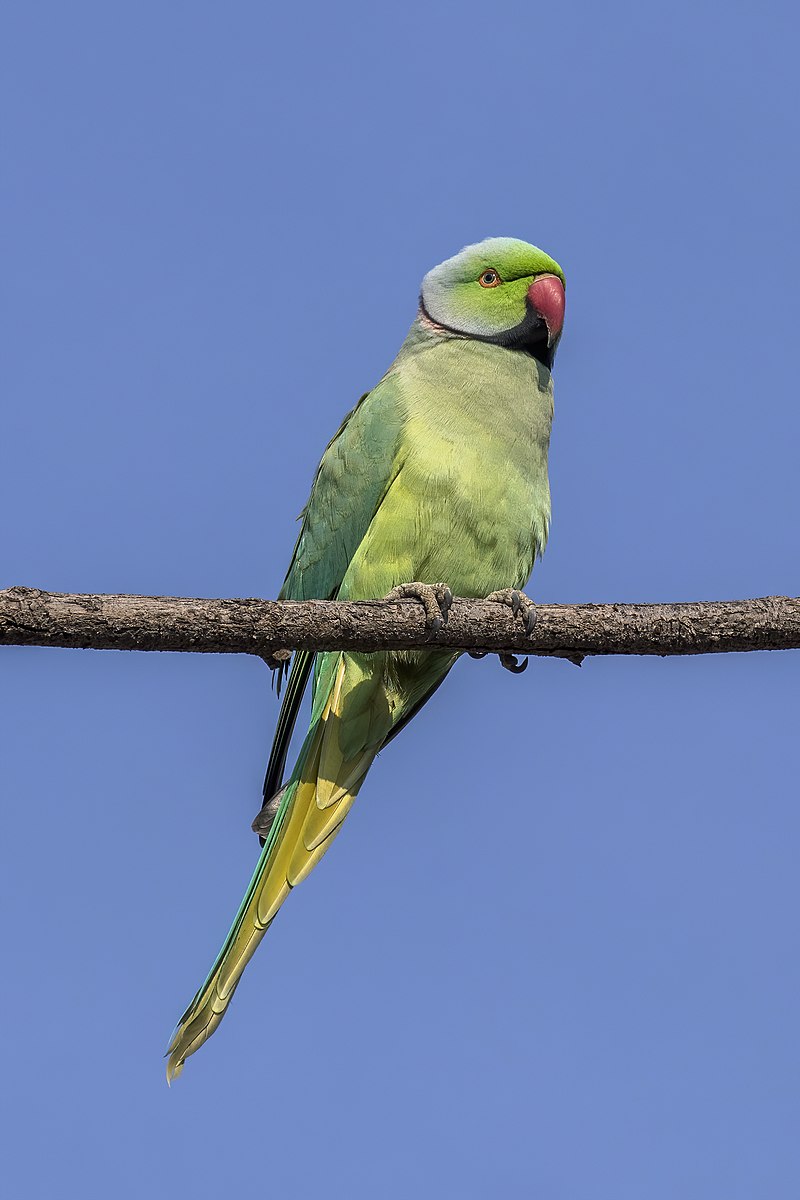
The Rose-ringed parakeet is a medium-sized bird in the family Psittacidae. Native to Africa and India, it has been introduced into many other parts of the world where feral populations have established themselves.
The most distinctive feature of this species is its colorful neck ring, which ranges from pink to purple and gives them their name.
However, males often display more vibrant colors than females do. This beautiful bird can also imitate human speech, making them popular pets worldwide.
In addition, they are very social creatures, preferring large flocks when out in nature or as part of aviaries during captivity. With proper care, these birds can live up to 30 years.
Scientific classification:
| Kingdom | Animalia |
| Phylum | Chordata |
| Class | Aves |
| Order | Psittaciformes |
| Family | Psittaculidae |
| Genus | Psittacula |
| Species | P. krameri |
32. Hawaiian Stilt
The Hawaiian Stilt is an endangered subspecies of the Black-necked Stilt, a long-legged shorebird with a slender beak.
It’s also known as the Aeʻo, Kukuluaeʻo, or Hawaiian black-necked stilt and can mainly be found in Hawaii.
They are usually seen near coastal wetlands such as lagoons and tidal flats, where they spend most of their time searching for food, like worms and insects in shallow water areas.
The main threats to this species include habitat loss due to urbanization and wetland drainage, which has caused their populations to decline significantly over recent years.
Conservationists are working hard to restore these habitats so that these birds have more suitable places to live and their population numbers can increase again.
Scientific classification:
| Kingdom | Animalia |
| Phylum | Chordata |
| Class | Aves |
| Order | Charadriiformes |
| Family | Recurvirostridae |
| Genus | Himantopus |
| Species | H. mexicanus |
| Subspecies | H. m. knudseni |
33. Northern Mockingbird
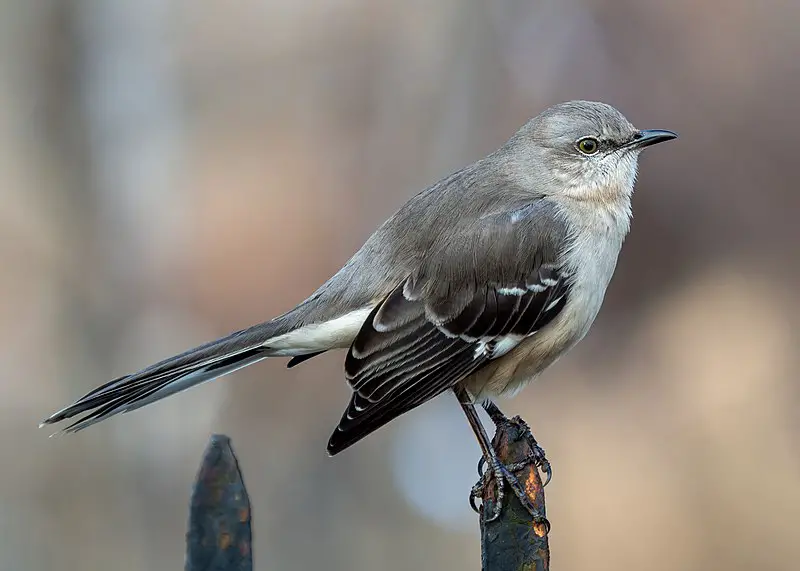
The northern mockingbird is a common fixture in North American skies. It has greyish-brown upperparts and a paler underside with white wing patches, and its distinctive long tail makes it easy to spot.
This adaptable bird can often be seen singing from the tops of trees or fences, though it rarely strays into Europe.
Carl Linnaeus first described the species in his 1758 Systema Naturae as Turdus polyglottos – aptly named for their remarkable ability to mimic other birds’ songs.
Northern mockingbirds typically live on insects, fruits, berries, and seeds, but they will also happily scavenge food scraps left out by humans.
This beloved avian contributes to our environment with its beautiful song and striking plumage.
Scientific classification:
| Kingdom | Animalia |
| Phylum | Chordata |
| Class | Aves |
| Order | Passeriformes |
| Family | Mimidae |
| Genus | Mimus |
| Species | M. polyglottos |
34. Newell’s Shearwater
Newell’s Shearwater, also known as the Hawaiian Shearwater, is an ocean bird belonging to the family Procellariidae.
This species can be difficult to identify due to its similarities with other shearwaters and its somewhat controversial classification – it was formerly treated as a subspecies of Manx shearwater but is now more commonly placed in Townsend’s shearwater.
It is endemic to Hawaii, where they breed on several offshore islands such as Maui’s Molokini Islet and Lana’i Island.
These birds are mostly dark brown with white bellies and have short wings, enabling them to soar over long distances at sea while searching for food like flying fish eggs or squid.
They feed mainly by diving into water from mid-air using their strong feet for propulsion underwater surface before resurfacing again
Scientific classification:
| Kingdom | Animalia |
| Phylum | Chordata |
| Class | Aves |
| Order | Procellariiformes |
| Family | Procellariidae |
| Genus | Puffinus |
| Species | P. newelli |
Also Featured In: Guam Birds You Need to See, Beautiful Birds Found in Lehua
35. Hawaiian Duck
The Hawaiian duck, also known as Koloa, is an endemic bird of the large islands in Hawaii. It belongs to the Anatidae family and is closely related to mallard ducks.
The main difference between these two species is their looks; while male and female Mallards have different colors, Hawaiian Ducks are monochromatic with similarly marked males and females.
Unlike other Anas genus ducks, this species does not migrate from its habitat.
With a brownish-grey coloration on its body along with bright green head feathers, this beautiful creature can be seen mostly near ponds or vegetation areas around Hawaii’s coasts, where they feed mainly on aquatic plants like algae and insects found there.
Scientific classification:
| Kingdom | Animalia |
| Phylum | Chordata |
| Class | Aves |
| Order | Anseriformes |
| Family | Anatidae |
| Genus | Anas |
| Species | A. wyvilliana |
36. Erckel’s Spurfowl
Erckel’s spurfowl is a species of game bird in the family Phasianidae. It was first described by German naturalist Eduard Rüppell, who named it after his assistant Theodor Erckel.
This beautiful bird has various colors – its plumage features shades of brown, white, and black on its body, with striking red wattles around their eyes and beak.
Their diet mostly consists of seeds, small insects like grasshoppers, beetles, termites, and fruits found in forests or open areas near water bodies.
They are usually seen foraging alone or in pairs. Still, they can form large flocks during the breeding season, from February to June, when males perform courtship displays of strutting along alternate routes while calling loudly to attract mates.
Erckel’s Spurfowl provides sport hunting opportunities throughout East Africa due to their abundance, making them a popular quarry among hunters year-round.
Scientific classification:
| Kingdom | Animalia |
| Phylum | Chordata |
| Class | Aves |
| Order | Galliformes |
| Family | Phasianidae |
| Genus | Pternistis |
| Species | P. erckelii |
37. Common Waxbill
The Common Waxbill is a beautiful small passerine bird native to sub-Saharan Africa.
It has become popular in captivity and can be found worldwide, with an estimated global extent of occurrence of 10 million km2.
Carl Linnaeus provided its formal description in 1758 as part of his Systema Naturae; he gave it the scientific name Estrilda astride.
This species is mainly greyish brown or olive green on its upper parts while having chestnut-colored wings and tail feathers tipped with white or creamy yellow.
They have red eyes, pink bills, and legs, giving them an attractive appearance overall.
The Common waxbill feeds primarily on grass seeds but occasionally takes insects. It breeds readily in aviaries, making it a great choice for avid bird keepers.
Scientific classification:
| Kingdom | Animalia |
| Phylum | Chordata |
| Class | Aves |
| Order | Passeriformes |
| Family | Estrildidae |
| Genus | Estrilda |
| Species | E. astrild |
38. Yellow-Fronted Canary
The Yellow-Fronted Canary is a small passerine bird in the finch family, often referred to as “the Green Singing Finch” by aviculturists.
It has bright yellow feathers, greyish-brown wings, and a tail around its head and face.
This species was formerly placed within the Serinus genus. However, analysis of mitochondrial and nuclear DNA sequences revealed this grouping to be polyphyletic; thus, it now stands alone in its genus, Crithagra Mozambique.
The canary enjoys open woodlands or scrubland habitats where they can sing beautiful songs from dawn until dusk. This activity also serves as territorial behavior for males during mating season.
In addition, these birds feed on various grains such as grass seeds, buds & shoots of plants, or even insects when possible.
With proper care & nutrition, these lovely little birds can live up to 8 years, making them a delightful pet choice.
Scientific classification:
| Kingdom | Animalia |
| Phylum | Chordata |
| Class | Aves |
| Order | Passeriformes |
| Family | Fringillidae |
| Subfamily | Carduelinae |
| Genus | Crithagra |
| Species | C. mozambica |
39. White Tern
The White tern, also known as the common white tern or Fairy Tern, is a small seabird species found across tropical oceans worldwide.
Known for its elegance and beauty by humans and other animals, these birds are mesmerizing with snow-white feathers.
They can be seen soaring in high altitudes or circling ships at sea looking for food. The Hawaiian name ‘manu-o-Kū’ translates to ‘bird of heaven,’ reflecting how majestic this bird looks when it flies through the sky.
These lovely creatures often breed on isolated islands away from predators, along with another smaller species called Little White Terns (Gygis microrhyncha).
Scientific classification:
| Kingdom | Animalia |
| Phylum | Chordata |
| Class | Aves |
| Order | Charadriiformes |
| Family | Laridae |
| Genus | Gygis |
| Species | G. alba |
40. Hawaiian Coot
The Hawaiian Coot, also known as the ʻ’alae ke’oke’o in Hawaiian, is a striking bird species found only on Hawaii’s islands. It has an overall black plumage and a prominent white bill with a yellow spot at its base.
The coot measures 13-16 inches long and weighs about 1 pound 9 ounces when fully grown. They are similar to American Coots but have adapted well to their tropical home habitat.
Generally, they can be seen foraging along lakes or wetlands where plenty of mud or shallow water is available to feed from aquatic vegetation such as algae, grasses, and insects that live beneath its water surface.
These birds are highly social animals, preferring company while swimming around together during mating season, generally between spring and summer months each year in Hawaii.
Scientific classification:
| Kingdom | Animalia |
| Phylum | Chordata |
| Class | Aves |
| Order | Gruiformes |
| Family | Rallidae |
| Genus | Fulica |
| Species | F. alai |
41. Chestnut Munia
The Chestnut munia is a small passerine bird in many parts of Asia. It has a glossy black head, chest, and wings with white patches along its back and belly.
Its bill is conical shaped, while the eyes are dark brown to blackish colored. This species can be seen foraging on grasslands, wet fields, or around farmlands, where it eats various kinds of grains, insects, and sometimes weeds.
Breeding pairs form during the summer when they construct nests using grasses placed near shrubs or trees.
A clutch consists of 2-6 eggs with greyish-white coloration and blotched markings at times.
The female incubates them for about 11 days before hatching, after which both parents feed their young ones until they fledge out from the nest within 16–21 days post-hatch date.
Scientific classification:
| Kingdom | Animalia |
| Phylum | Chordata |
| Class | Aves |
| Order | Passeriformes |
| Family | Estrildidae |
| Genus | Lonchura |
| Species | L. atricapilla |
42. Saffron Finch
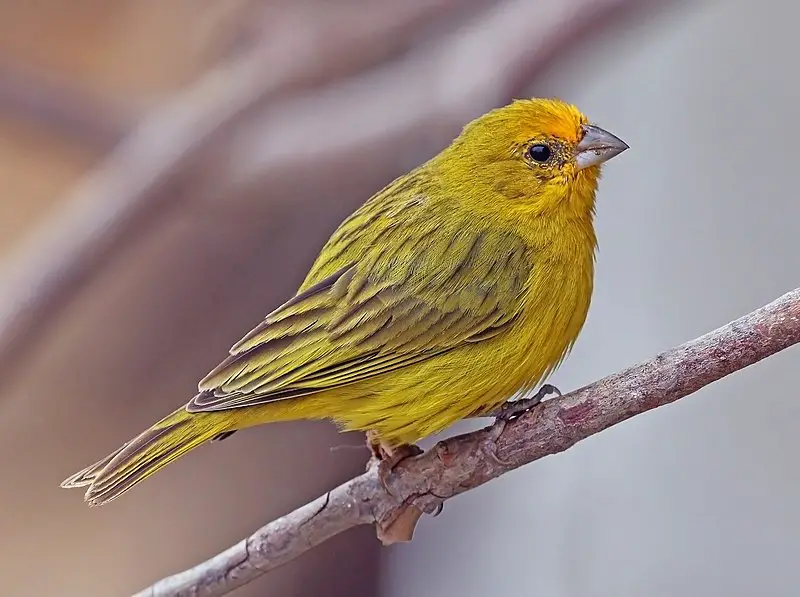
The Saffron Finch is a small tanager bird found in South America. This delightful species has an extensive distribution, ranging from Colombia to eastern Brazil and Bolivia.
They inhabit open or semi-open habitats at low elevations outside the Amazon Basin.
With their easily recognizable bright yellow feathers and cheerful song, they are often seen perching on roofs in northern Venezuela, where they are referred to as “canario de Tejada.”
In southern Brazil these birds are known as “canário-da-terra”, which translates into native canary.
Their diet consists mainly of seeds, grains, and insects such as grasshoppers, caterpillars, and beetles.
Although not threatened with extinction, deforestation may reduce their available habitat significantly if measures aren’t taken to conserve it.
Scientific classification:
| Kingdom | Animalia |
| Phylum | Chordata |
| Class | Aves |
| Order | Passeriformes |
| Family | Thraupidae |
| Genus | Sicalis |
| Species | S. flaveola |
43. Cattle Egret
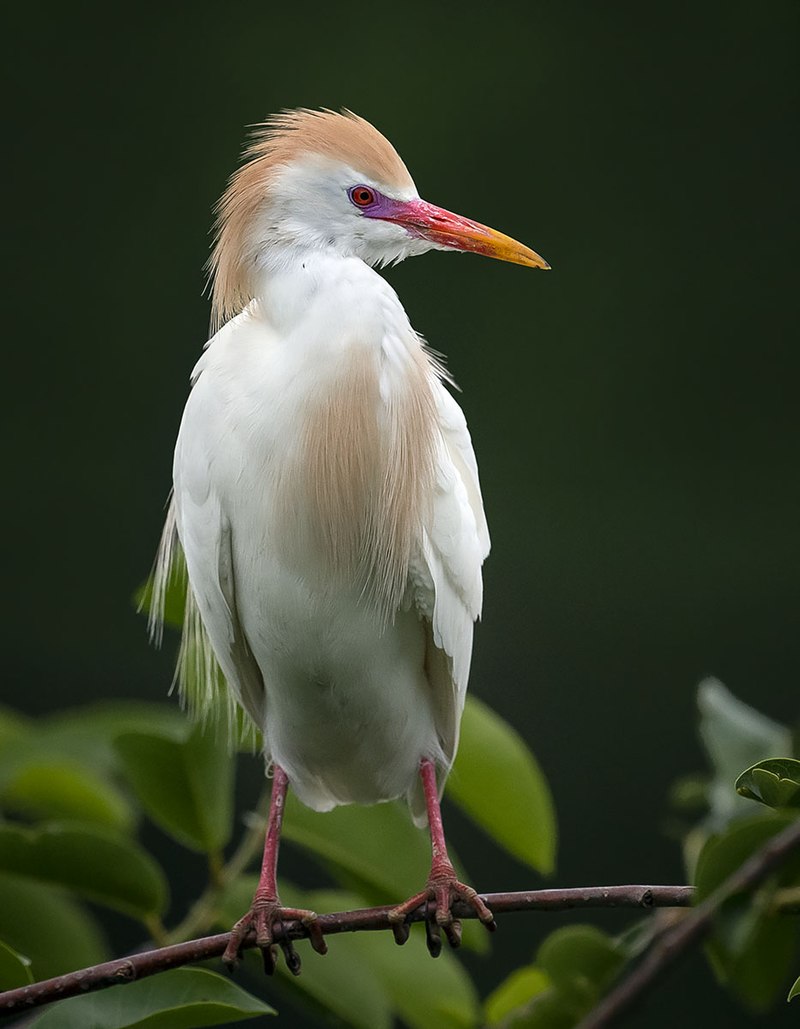
The Cattle Egret is a heron of the family Ardeidae found worldwide in tropical, subtropical, and warm temperate areas. It has two subspecies: western cattle egret and eastern cattle egret.
They have white plumage with buff plumes on their head, neck, and back. The beak is yellowish-orange with a black tip, while the legs are orange or yellow colored depending on species variation.
This bird usually feeds near large herds of animals, such as cows, horses, etc., where it finds plenty of insects, like grasshoppers, crickets, etc.
Its presence benefits these animals by removing ectoparasites from them, which leads to a healthier livestock population.
It nests colonially in trees or shrubs close to water bodies during the breeding season, generally occurring between March and June every year.
Scientific classification:
| Kingdom | Animalia |
| Phylum | Chordata |
| Class | Aves |
| Order | Pelecaniformes |
| Family | Ardeidae |
| Genus | Bubulcus Bonaparte, 1855 |
| Species | B. ibis |
44. Grey Francolin
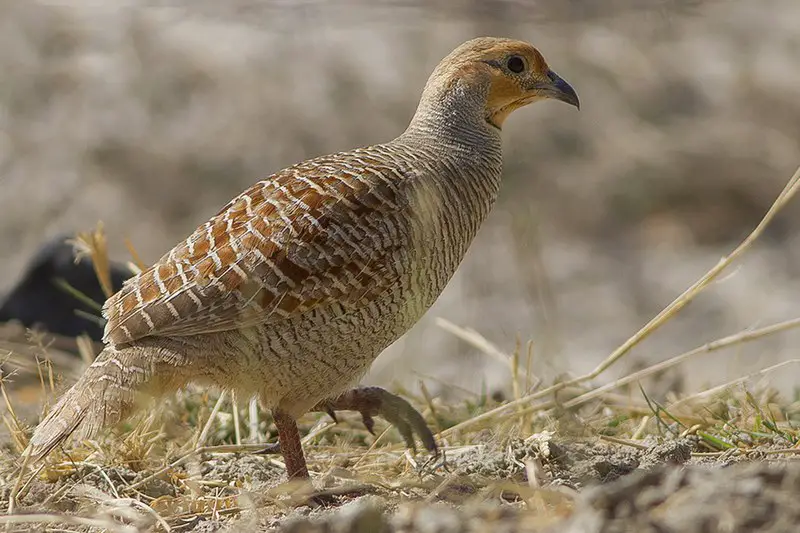
The Grey Francolin is a species of francolin found in the plains and drier parts of India, Iran, and some other areas.
It was formerly called the grey partridge but should not be confused with the European version.
This bird usually lives on the ground where it finds open cultivated land. It has also been called “manu moa” or “chicken bird.”
The colors can range from brownish-grey to dark grey along its body, while black markings are near its forehead.
Its diet typically consists of seeds, leaves, insects, and sometimes fruits, which they search for around bushes or tall grasses during early morning hours when these birds are most active.
Scientific classification:
| Kingdom | Animalia |
| Phylum | Chordata |
| Class | Aves |
| Order | Galliformes |
| Family | Phasianidae |
| Genus | Ortygornis |
| Species | O. pondicerianus |
Also Featured In: Common Birds that Live in Odisha, Birds of Karnataka
45. Northern Storm Petrels
Northern storm petrels are one of the smallest seabirds, inhabiting oceans worldwide.
They can hover over water and pick planktonic crustaceans and small fish from the surface.
Northern storm petrels belong to the genus Hydrobates in the family Hydrobatidae, part of the Procellariiformes order.
This species was once lumped with austral storm petrel, but recent studies show that they weren’t closely related, leading to them being split into two distinct species.
These birds can be identified by their dark grey upperparts, wings, and white underparts when seen from afar while feeding on the ocean’s surface.
Scientific classification:
| Kingdom | Animalia |
| Phylum | Chordata |
| Class | Aves |
| Order | Procellariiformes |
| Family | Hydrobatidae Mathews, 1912 |
| Genus | Hydrobates F. Boie, 1822 |
46. Hemignathus
Hemignathus is a genus of Hawaiian honeycreeper birds found exclusively in the islands.
Human actions have greatly affected these beautiful and vibrant creatures over the last two centuries – habitat destruction, introduction of predators, and, more significantly, mosquito-borne diseases have all contributed to their decline in numbers.
The most notable species is the giant nukupu’u (Hemignathus vorpalis), which has become extinct due to these pressures.
Conservation efforts must be increased if we preserve what little remains of this unique family for future generations.
Scientific classification:
| Kingdom | Animalia |
| Phylum | Chordata |
| Class | Aves |
| Order | Passeriformes |
| Family | Fringillidae |
| Subfamily | Carduelinae |
| Genus | Hemignathus Lichtenstein, MHC, 1839 |
47. Pueo
Pueo is a subspecies of the short-eared owl and is endemic to Hawaii. It is important in Hawaiian culture, as it often appears as ʻaumākua (ancestor spirits).
These birds live in forests and grasslands throughout the islands of Hawaiʻi. They are unfortunately becoming rare due to habitat loss, but they continue to be deeply respected by local communities for their spiritual significance.
Pueo have unique physical characteristics such as yellow eyes, grayish brown feathers with white markings on their wings and head, and long legs with feathered feet, which help them hunt fast-moving prey like rodents during dusk or dawn hours.
Despite declining numbers across Hawaii, pueos remain a beloved part of Hawaiian culture that inspires awe today.
Scientific classification:
| Kingdom | Animalia |
| Phylum | Chordata |
| Class | Aves |
| Order | Strigiformes |
| Family | Strigidae |
| Genus | Asio |
| Species | A. flammeus |
| Subspecies | A. f. sandwichensis |
48. Kauaʻi ʻōʻō
The Kauaʻi ʻōʻō was a medium-sized bird endemic to the Hawaiian island of Kauai. It belonged to the Mohoidae family and was part of the ʻōʻō genus until its extinction in 1987.
The bird had white feathers, black wings and tail feather tips, and yellow feet and legs.
Its call sounded like “ooh-oo” or “ahh-ah”. The Kaua’i ‘O’O mainly fed on nectar from flowers but also ate insects such as beetles and ants.
This species lived primarily in subtropical forests, but due to habitat destruction, it became increasingly rarer before finally becoming extinct in 1987 when the last known individual died out.
This is just one example of how human activity can lead to extinctions around us – we must help preserve what we have left.
Scientific classification:
| Kingdom | Animalia |
| Phylum | Chordata |
| Class | Aves |
| Order | Passeriformes |
| Family | †Mohoidae |
| Genus | †Moho |
| Species | †M. braccatus |
Conclusion
Hawaii boasts a remarkable diversity of bird species, with approximately 48 unique avian inhabitants. These birds, many of which are endemic to the islands, contribute to the rich ecological tapestry of Hawaii.
However, they face numerous challenges, including habitat loss, invasive species, and climate change. Conservation efforts are vital to ensure the survival of these precious species for future generations to appreciate and enjoy.